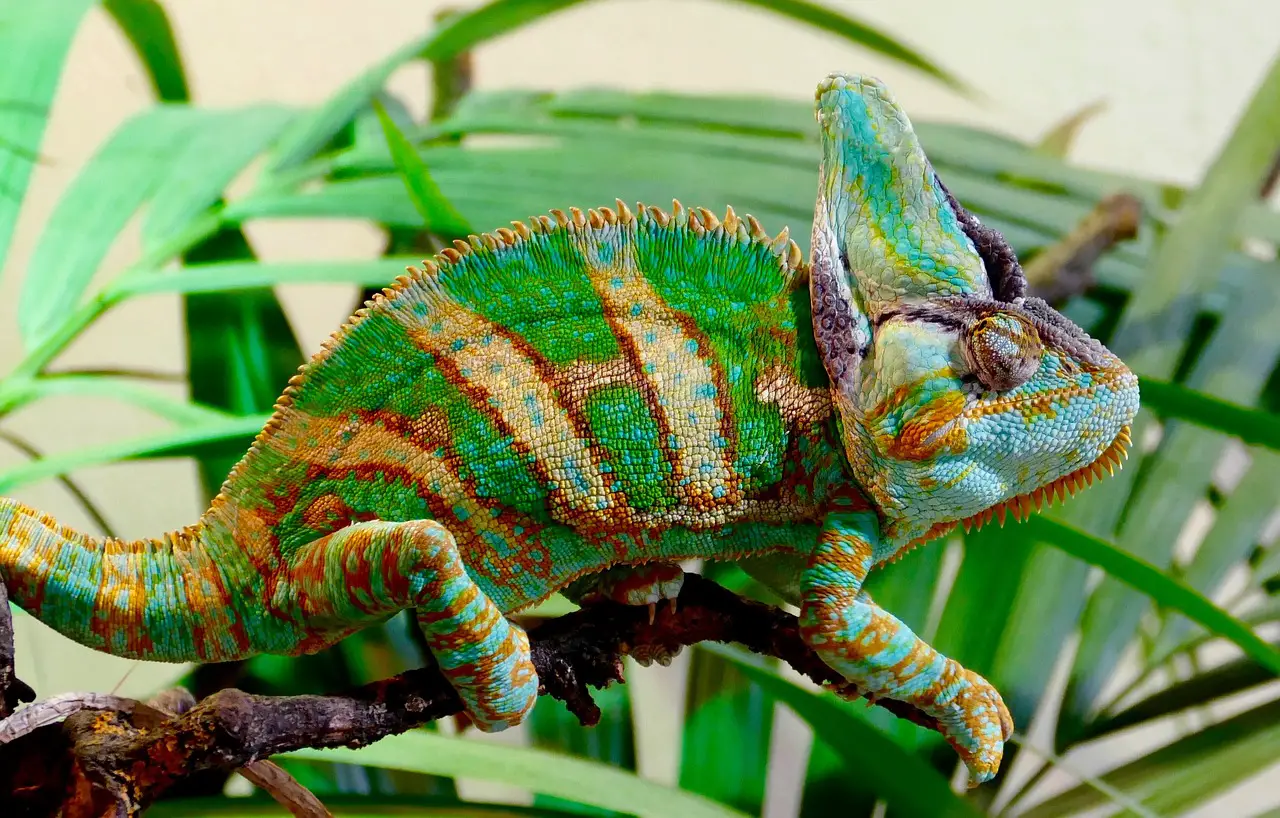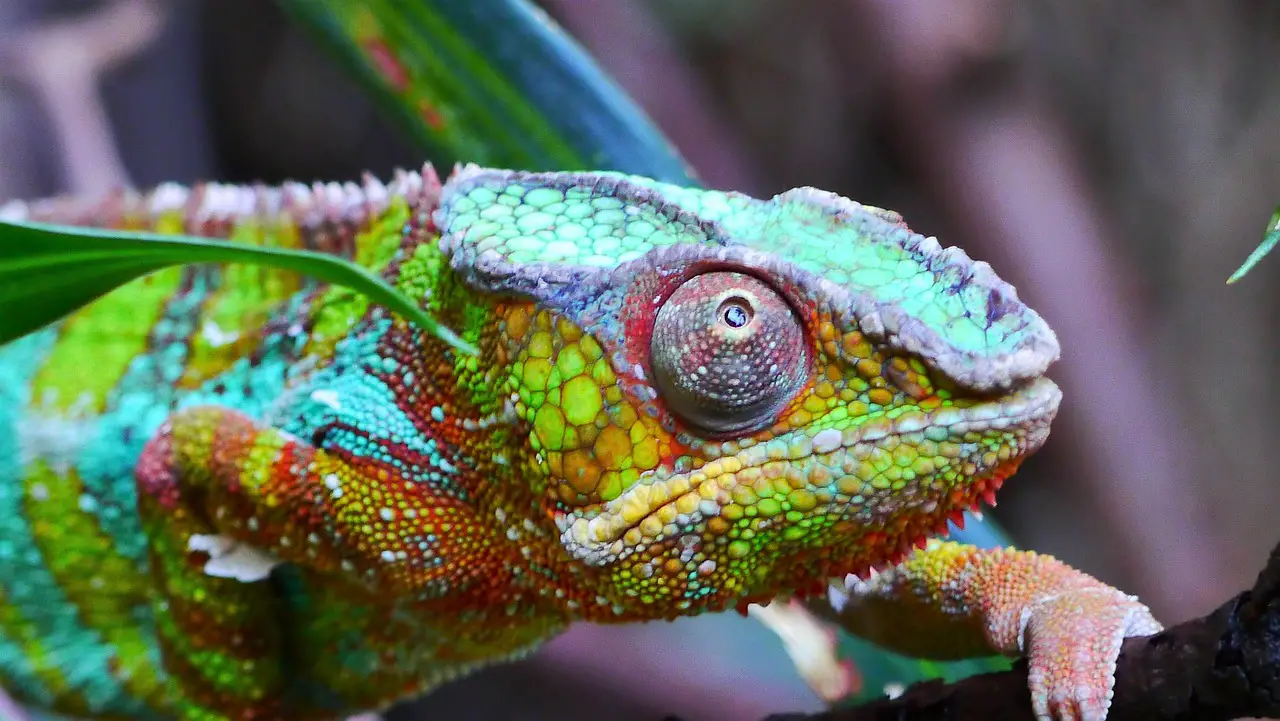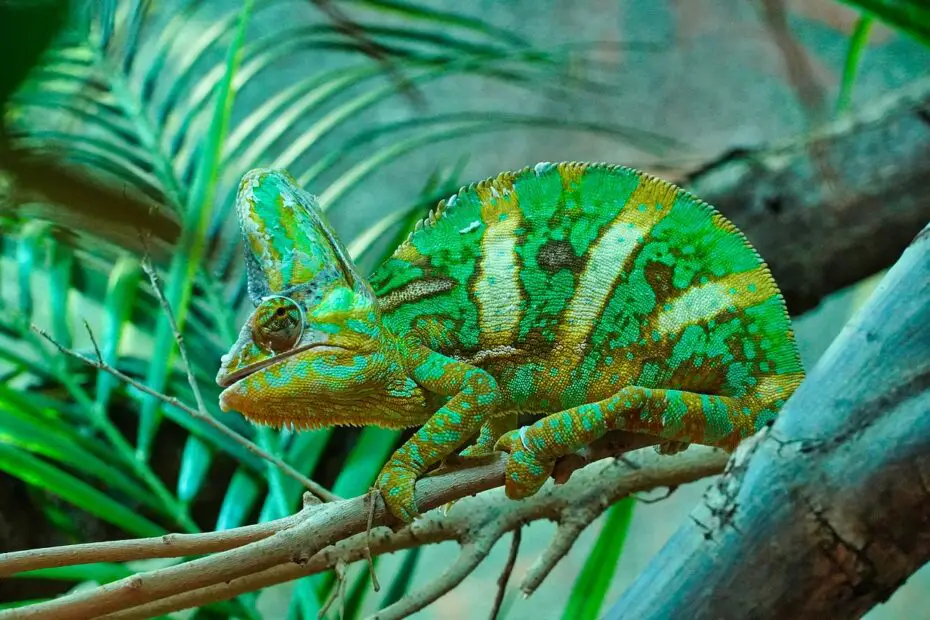Imagine a creature that can change its colors and blend seamlessly into its surroundings, its eyes swiveling independently to keep watch for prey and predators. Such remarkable beings do exist, and they are called chameleons. These enigmatic reptiles are celebrated for their unparalleled ability to adapt to their environments through color-changing camouflage, their distinctive anatomy, and their captivating behaviors.
In this blog, we will embark on a journey into the captivating world of chameleons, exploring their evolution, unique characteristics, and the secrets behind their mesmerizing camouflage.
You may also want to know how fast an alligator runs.
The Chameleon Family
Chameleons belong to the family Chamaeleonidae, which is part of the larger group of lizards known as squamates. This family consists of approximately 200 recognized species distributed across Africa, Madagascar, southern Europe, the Middle East, and parts of Asia. Madagascar, in particular, is a biodiversity hotspot for chameleons, hosting an impressive array of species.

The Marvel of Camouflage
One of the most remarkable and well-known features of chameleons is their camouflage ability. Their skin is adorned with specialized cells called chromatophores, which contain pigments responsible for the colors we see. Chameleons can manipulate these chromatophores to change their skin color and patterns almost instantaneously, allowing them to blend into their surroundings or communicate with other chameleons.
Camouflage for Predation
Camouflage serves several purposes in a chameleon’s life. When stalking prey, they can adopt a mottled green or brown appearance to blend into foliage, making them nearly invisible to potential prey items like insects. Their stealthy approach, combined with their remarkable accuracy when striking at prey with their projectile tongue, is a testament to their effectiveness as predators.
Camouflage for Protection
Chameleons also employ camouflage as a defense mechanism. When faced with a threat, they can change colors to intimidate or confuse predators. Some species may even flash bright colors as a warning, signaling that they are unpalatable or venomous.
The Complex Anatomy of Chameleons
Chameleons have a range of distinctive physical features that contribute to their unique lifestyle and behavior:
Prehensile Tail
Many chameleons possess a prehensile tail that acts as a fifth limb. This tail is incredibly dexterous, allowing chameleons to grasp branches securely and maintain balance as they navigate their arboreal habitats.
Turret-Like Eyes
Chameleons are renowned for their independently mobile, turret-like eyes. Each eye can move independently, providing them with panoramic vision and an exceptional ability to spot both prey and predators. This 360-degree vision is essential for their survival.
Stereoscopic Vision
While each eye can move independently, they can also converge to provide binocular vision when focusing on a specific target, such as prey. This enables them to gauge distances accurately and accurately aim their projectile tongues.
Specialized Feet
Chameleons have unique feet adapted to their arboreal lifestyle. Their feet are divided into two main groups: zygodactylous (two toes forward and two toes backward) or pygopodous (a fused group of toes for improved gripping). These adaptations help them traverse tree branches with ease.
World of Chameleons: The Secret Behind Chameleon Color Changes
The ability to change color is a chameleon’s most famous trait, and it is essential for their survival. Here’s how they achieve this remarkable feat:
Chromatophores
Chameleons have specialized cells called chromatophores that contain pigments. These cells are situated beneath the outer layer of their skin and are controlled by the chameleon’s nervous system.

Hormonal Control
Chameleons can change color in response to various factors, including temperature, mood, and environmental stimuli. Hormones regulate these changes, influencing the contraction or relaxation of the chromatophores.
Structural Coloration
While chromatophores play a vital role in color changes, structural coloration is another key factor. Chameleon skin contains layers of nanocrystals that reflect and scatter light. By manipulating the spacing between these nanocrystals, chameleons can alter the colors we perceive.
Communication
Chameleons also use their color-changing abilities to communicate with each other. Males, in particular, may display vibrant colors during territorial disputes or courtship rituals. These displays signal aggression, submission, or readiness to mate.
A Diverse Array of Species
Chameleons are a diverse group, with each species showcasing unique characteristics, behaviors, and adaptations. Here are a few notable examples:
Veiled Chameleon (Chamaeleo calyptratus)
The veiled chameleon, native to Yemen and Saudi Arabia, is known for its striking coloration and tall casque (helmet-like structure) on its head. Males often display vibrant hues of green, blue, and yellow when excited or threatened.
Panther Chameleon (Furcifer pardalis)
Endemic to Madagascar, the panther chameleon is famous for its incredible range of colors, including shades of red, blue, green, and orange. They have a distinctive casque and are often kept as pets due to their stunning appearance.
Jackson’s Chameleon (Trioceros jacksonii)
Named after the famous conservationist Percy FitzPatrick, Jackson’s chameleon hails from Kenya and Tanzania. It is characterized by its three distinct horns on its head and a prominent dorsal crest. These chameleons are relatively small compared to their relatives.
Parson’s Chameleon (Calumma parsonii)
The Parson’s chameleon, also native to Madagascar, is one of the largest chameleons in the world. Its size, intricate patterns, and unique coloration make it a captivating species to observe in its natural habitat.
Conservation Challenges
While chameleons are masters of camouflage, they are not immune to the threats facing many species today:
Habitat Loss
Deforestation and habitat destruction in their native ranges are a significant concern. As forests disappear, chameleons lose their homes and the prey they rely on.
Pet Trade
Chameleons are popular in the exotic pet trade, leading to overharvesting and illegal trafficking. Unsustainable collection practices can harm wild populations.
Climate Change
Climate change is altering the habitats of chameleons, affecting their distribution and behavior. Rising temperatures can impact their ability to thermoregulate and find suitable prey.
Conservation Efforts
Conservation organizations, researchers, and governments are actively working to protect chameleons and their habitats. Efforts include:
Habitat Conservation
Creating and expanding protected areas and wildlife corridors to preserve chameleon habitats and promote healthy populations.
Research
Studying chameleon behavior, biology, and ecology to better understand their needs and develop effective conservation strategies.
Education
Raising public awareness about the importance of conserving chameleons and their habitats, as well as promoting responsible pet ownership.
Legal Protections
Enforcing laws and regulations to prevent the illegal trade of chameleons and protect their native habitats.
Conclusion of The World of Chameleons
Chameleons are living marvels, captivating us with their color-changing abilities, unique anatomy, and intriguing behaviors. Their remarkable adaptations have allowed them to thrive in diverse environments, from dense rainforests to arid deserts. However, like many other species, they face numerous challenges in a rapidly changing world.
As we continue to uncover the secrets of these mesmerizing reptiles, it becomes increasingly important to protect their habitats and ensure their survival. By supporting conservation efforts, advocating for responsible pet ownership, and raising awareness about the significance of these masterful camouflagers, we can contribute to the preservation of chameleons and the rich biodiversity they represent.
The world of chameleons is a testament to the wonders of evolution and the incredible diversity of life on Earth, deserving of our admiration and protection.
